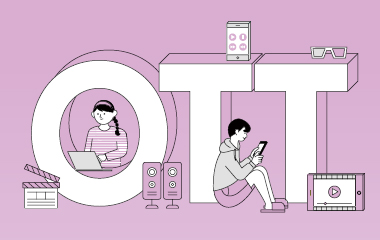
Over-the-top (OTT) services refer to services that provide video content on various devices such as tablet PCs and smartphones based on Internet technology. OTT has been growing rapidly since the 2010s by maximizing consumer convenience with a personalized content curation system, and not just as video content playback platform. Unlike conventional broadcast media, this service provides users with flexibility in channel selection. OTT users can pay for the service and easily stream the videos online instead of having to download each file.

They can even watch real-time broadcasts by accessing the platform about an hour after a broadcast ends. Even programs on air are uploaded onto OTT platforms immediately after the broadcast, so OTT users do not have to watch television on time. It is assumed that this convenience of not having to watch television is as the reason for the explosive increase in the number of OTT users. As time consumption at home increased after the outbreak of COVID-19, watching videos using the OTT platform became the main form of entertainment. In other words, cultural life changed with COVID-19 and the demand for OTT platforms grew. Therefore, many people have shifted from TV broadcasting to OTT platforms like “Netflix,” “Watcha,” and “Wavve.”

Regarding the increase of media content consumption through OTT has in accordance with the prolonged COVID-19 pandemic, The UOS Times surveyed 81 college students to find out the degree of awareness and utilization of OTT services among them.
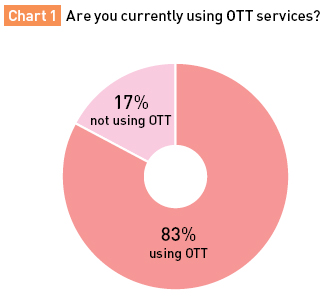
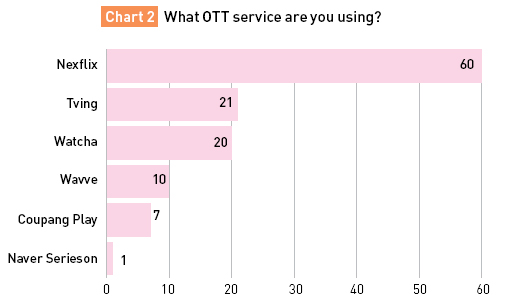
For Question 1, 83 percent of answered that they were using OTT services, and 17 said that they were not. As many as 60 students said that they use Netflix. Netflix, the world’s largest media company, is gaining popularity with its original content. Its unique differentiation stands out not only in the Korean market but also world over, producing K-content such as “Squid Game” and “My Name.”
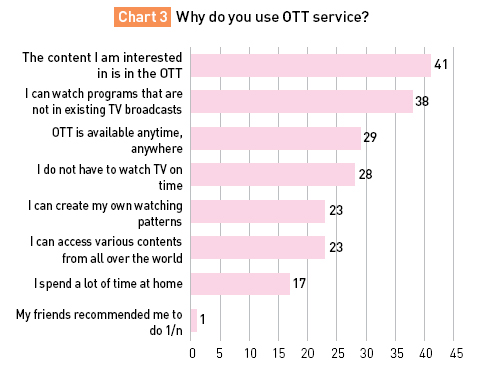
OTT has some advantages in that it provides self-produced content that is not available on TV. Users have access to various programs from around the world. Watcha, a domestic OTT service, has over 500 million program evaluation tables left behind by more than millions of users. It develops a recommendation algorithm with this data and provides customized recommendation services for each user. Therefore, users are willing to pay subscription fees allured by various contents and curations that cater to their tastes. College students responded saying that they are using OTT because OTT can be watched at any time and anywhere, and one does not have to watch TV on time.

Despite the advantages of OTT services, some people do not use them. A total of 14 students said that they do not want to pay monthly subscription fees. Some said that they were not very interested in watching media and videos, so they have not felt the need to use OTT services.

[Chart 5] shows that 81.2 percent of users had subscribed to OTT services for more than six months. All OTTs are available to four people per one account, thus some people pay subscription fees on behalf of three of their acquaintances. Therefore, in general, it is safe to say that one person uses one OTT at a time, and about KRW 4,000 is paid. [Chart 7] shows that 61 percent of students use at least two OTTs. Over half the users said that they watch videos for about five hours each week. This seems to be the case because users can play and watch videos regardless of the time and place.
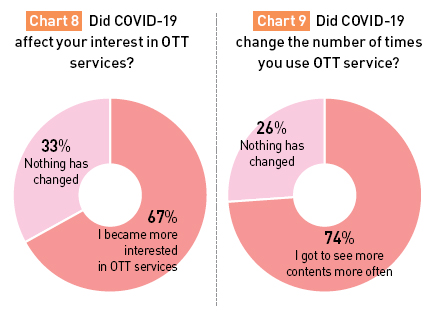
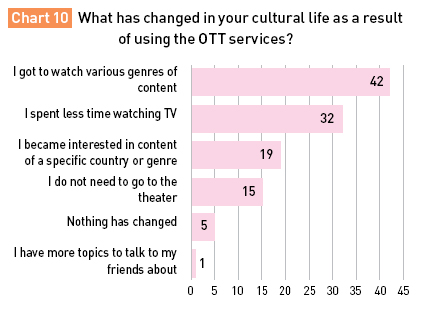
According to [Chart 8] and [Chart 9], it is clear that the influence of the COVID-19 pandemic has caused users to increase their frequency of and interest in watching content on OTT platforms. As people were forced to spend more time at home because of the COVID-19 pandemic, they said that they were interested in shows from particular countries and genres. Users said that they gradually stopped watching TV and/or going to the movie theater as they were able to access OTT services and watch the programs they wanted to watch at any time. The growth of OTT has changed the pattern of media consumption. Thus, students said that OTT should produce more differentiated content. They also said that as the OTT market grows, it becomes more difficult for the broadcasting and film industries to enter the media market and consumers are more likely to fall into digital device addiction.

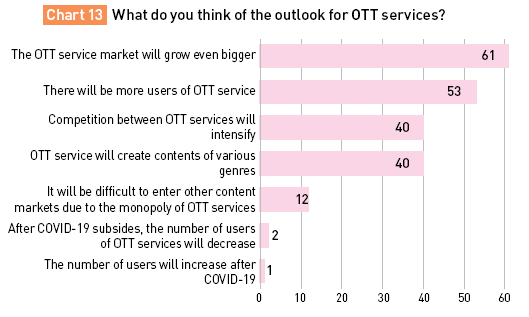
Many students predicted that OTT services would become more active, produce various kinds of content, and intensify the competition between OTTs. Further, 93 percent of the respondents said that they would continue to use OTT services.
There are advantages and disadvantages to using OTT services. The UOS Times introduces both sides to using OTT services as follows.
First, the biggest advantage of OTT services is convenience. If consumers do not use OTT services, they have to watch shows when they air or only on the device on which they shall have the media download. However, with OTT services, if they are in an environment where streaming is possible, they can enjoy the media at any time and place they want.
Second, OTT services are inexpensive, because the main service is not video downloading. OTT services often allow multiple people to share an account and access it at the same time. Therefore, lower fees allow for consumers to share accounts. Third, OTT services provide many kinds of media content, such as dramas, movies, and documentaries, and in genres, such as romance, thrillers, comedies, and so on. Consumers can choose from a wide range of options. Fourth, OTT services offer a lot of options that allow consumers to enjoy media more. By using personal taste analysis algorithms, consumers can look up media content that aligns with their tastes, such as their favorite genres. The provision of multilingual subtitles by several OTT services has received positive reviews in that it increases media accessibility for the hearing-impaired and others.
Finally, OTT services have mobilized huge capital to produce their original series beyond merely distributing existing media. Most OTT services are provided in many countries. Therefore, as the OTT service industry grows, consumers world over will be able to receive higher-quality media. Producers also will be able to inform viewers worldwide of their media content. Several Korean drama series co-produced with OTT services have been exported worldwide, which has contributed to the improvement of Korea’s cultural competitiveness. Netflix’s original drama “Kingdom” was considered a fresh show, as it combined the zombie apocalypse with Joseon, an old Korean dynasty. “Squid Game” helped Korean culture gain global popularity by introducing Korean snacks and traditional games as the subject of the drama. The SF genre drama “Seungriho,” is said to have expanded the horizon of Korean media, because the SF genre has not been tried properly in Korea.

However, OTT services also have certain demerits. First, from the producer’s perspective, as OTT services have grown dramatically, the number of viewers of movies that are released in theaters and TV programs has decreased. Traditional media services have been gradually weakening as video platforms like YouTube and TikTok, which are easily accessible, and social media platforms that facilitate interactive communication, have grown. OTT services are spurring this growth. Some consumers are concerned that their options may decrease as OTT giants dominate the market. For example, with the launch of OTT services under the name of “Disney Plus” by giant entertainment firm Disney, the media produced by Disney may not be available on other platforms.
There are also concerns that Korean content producers may be subordinated to overseas OTT services like Netflix and Disney Plus, which can weaken the domestic environment in which the media can be produced. OTT services offer many options that increase consumer fatigue, as encapsulated by the term “Netflix Syndrome,” which refers to a phenomenon wherein consumers do not watch the media at all because they do not know what to see when they are overwhelmed with too much of it. People are not good at choosing when there are too many options to pick from. Finally, low service fees become a driving force for continued service subscriptions without using the service. It can also cause people to overspend.
The UOS Times interviewed Professor Lee Hee-dae of Kwangwoon University to understand what experts think of the bright and dark sides of OTT services.
Why are people enthusiastic about using OTT services?
Giant companies like Disney and Apple have entered the OTT service industry and new, large players have appeared in response to Netflix’s gradual success and recent fast growth. Owing to the COVID-19 pandemic, people were not able to go to the movie theaters. However, those who wanted well-made media such as movies turned to OTT services. In the first quarter of 2020, when the pandemic fears peaked worldwide, Netflix’s new subscribers reached about 10.9 million in number, and Disney Plus, which was launched less than two years ago, has more than 116 million subscribers. Despite the intensifying competition, the overall number of subscribers has increased.
What do media consumers think of the change in viewing patterns between traditional media like TV and online streaming services? How can OTT services coexist with TV broadcasters?
The number of users in OTT services exceeded traditional broadcasting media usage long ago. Through the development of the wired and wireless communication environment and the popularization of smartphones, watching videos on the Internet naturally occupied people’s daily lives. This is because people instinctively pursue benefits. They choose tools that are more convenient and beneficial. Compared to TV, smartphones overcome the limitations of time and space and have increased autonomy in accessing various media options. The success or failure of conventional broadcasters is expected to vary based on the kind of transformation they are trying to facilitate. The biggest difference between OTT services and broadcasting is that the former has no borders. Broadcasting in each country, including Korea, is legally restricted to its citizens alone. On the other hand, most OTT services are open through Internet networks world over. Conventional TV broadcasters must respond with a big picture strategy that predicts trends in the global and domestic market.
Recently, with the launch of overseas OTT services such as Disney Plus and Apple TV Plus in Korea, the OTT service market size is expanding. How will this affect the entire media market?
Although conventional broadcasters produce interesting, original content, if people use OTT services more than TV, broadcasters may have to provide OTT platforms with content in order to earn profits. Independent producers who make quality original content are more likely to use OTT platforms as their main providers. OTT companies which were introduced Korea with a global network, huge capital, and enormous original content will gradually increase their influence in Korea.
What do you think of the outlook for the OTT industry domestically and internationally?
The global and domestic domains may be somewhat different. In the global industry, other media groups that have watched Netflix’s success are expected to enter the OTT market themselves and compete. The competition for original content will intensify and OTT services will provide higher quality content than will TV, thus accelerating consumers’ movement from TV to OTT services. If global large capital OTT platforms enter Korea, consumers will decide to consume OTT rather than TV. The competitiveness that drives Korean users will be to see which platform provides the most Korean content that can be viewed comfortably without subtitles. OTT platforms also consider Korean content production a meaningful investment, so many original shows produced with their investments will be introduced in the future. Of course, consumers are expected to prefer OTT services to TV.
The UOS Times investigated the university students’ perceptions of OTT services by interviewing both students who actively use and do not show much enthusiasm for OTT services.
Student A uses four OTT services, namely Netflix, Watcha, Wavve, and Disney Plus, for about four hours a week. “However, I don’t use all services. I usually use Wavve, which has a lot of domestic dramas.” Student A pointed out that the biggest advantage of the service is that she can watch programs without over-adjusting her schedule. On the other hand, she considered wasted fee is a shortcoming because she did not use all platforms. She explained that the reason she subscribed to all OTT services was “the possibility that the programs I look for are not on the platforms I usually use.” She believes that OTT services will grow in the future because it is difficult to find friends who do not use OTT services around her. Many producers are choosing to collaborate with OTT services in order to meet the challenge of producing media of various genres. Therefore, more and more diverse media will be produced and consumers will be more enthusiastic about OTT services. She believes that the current situation in which OTT services are pushing out existing media is an opportunity for traditional media to grow. “TV broadcasts will also compete with OTT services to produce better media. It is a good opportunity for consumers.”
Student B said that she knew about the OTT services and had used some of them. However, she had not used them for a long time. She explained that she was not interested in OTT services, and said, “I don’t want to see any media. If there is anything I want to watch, I just search it separately. I have no need to open the way to access various media.” However, Student B said that the OTT service market will grow as long as people want to enjoy a variety of media content.

OTT services are already becoming a major part of the media content market and cannot be ignored. It remains to be seen whether OTT services can replace existing media platforms. However, the size of the OTT service market will grow and the competition between platforms will intensify. The potential energy of the OTT service market is consumers’ desire for various kinds of media content. For OTT services to grow in the future, media content must be diversified.
Hwang Yun-seon
mono071227@uos.ac.kr
Hwang Ha-hyun
madang8899@uos.ac.kr

